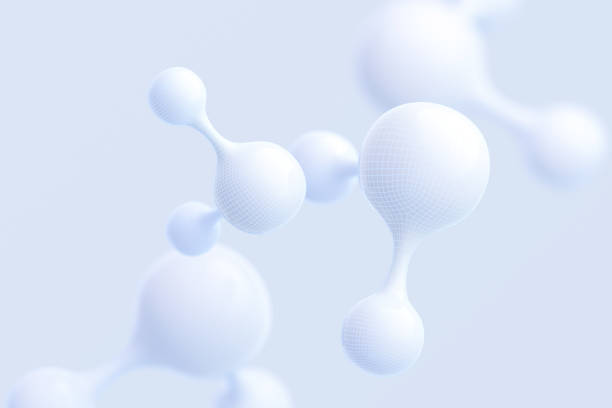Life, in all its astonishing diversity, is ultimately an expression of chemistry. From the smallest bacterium to the most complex human being, every living organism depends on intricate chemical processes that transform energy, build structures, and carry out the reactions necessary for survival. The chemistry of life explains how atoms and molecules come together to form cells, tissues, and organisms—and how those entities sustain themselves in a dynamic, ever-changing environment.
Understanding the chemistry of life means understanding the molecular basis of existence itself. It reveals how the same fundamental principles that govern nonliving matter—bonding, energy transfer, and reaction dynamics—operate in a more elaborate, regulated, and self-sustaining way in living systems. At its heart, biology is applied chemistry: life is not separate from chemistry but rather a remarkable consequence of it.
The Molecular Building Blocks of Life
All living organisms, regardless of complexity, are composed of the same basic types of molecules. The four major classes of biomolecules—carbohydrates, lipids, proteins, and nucleic acids—are the cornerstones of biochemistry. These molecules are built primarily from just a handful of elements: carbon, hydrogen, oxygen, nitrogen, phosphorus, and sulfur. Together, these elements make up more than 99 percent of the mass of most living cells.
Carbon is the central element of life’s chemistry because it can form four stable covalent bonds, creating long chains, rings, and complex three-dimensional structures. This versatility allows carbon-based molecules to serve as the backbone for the enormous diversity of organic compounds found in living organisms.
Carbohydrates provide energy and structural materials; lipids form membranes and store energy; proteins perform most cellular functions and catalyze reactions; and nucleic acids store and transmit genetic information. Although these molecules have distinct roles, their interactions and transformations are interconnected in an elaborate network known as metabolism—the sum total of all chemical reactions within an organism.
The Role of Water in Biological Chemistry
Water is often called the “universal solvent,” but in biology, it is much more than that. It is the medium in which life’s chemistry takes place, the matrix that allows molecules to move, react, and interact. Nearly 70 percent of the human body is water, and most biochemical reactions occur in aqueous environments.
The remarkable properties of water arise from its molecular structure. Each water molecule consists of two hydrogen atoms covalently bonded to one oxygen atom, forming a bent shape. This geometry creates a polar molecule—one end slightly positive (hydrogen) and the other slightly negative (oxygen). This polarity allows water molecules to form hydrogen bonds with each other and with other polar molecules, giving rise to its unique characteristics.
Hydrogen bonding gives water a high specific heat, meaning it can absorb and release large amounts of energy without drastic temperature changes. This property stabilizes the internal environment of organisms and the external environment of Earth’s ecosystems. Water’s high heat of vaporization also enables efficient cooling through evaporation.
Moreover, water’s solvent properties allow it to dissolve a vast range of substances. Ions and polar molecules disperse easily in water, forming solutions that are essential for metabolism. The interaction between water and biological molecules also determines the structure of proteins, the behavior of cell membranes, and the organization of DNA.
The Cellular Landscape: Chemistry in Motion
Every cell is a miniature chemical factory, conducting thousands of reactions simultaneously. These reactions do not occur randomly but are precisely organized in space and time. The cellular environment provides compartments and boundaries that enable different processes to take place efficiently.
Within the cytoplasm—the semi-fluid interior of the cell—countless reactions occur in a water-based solution of ions, small molecules, and macromolecules. Enzymes, specialized protein catalysts, accelerate these reactions, ensuring that the rates of essential processes are compatible with life.
Cell membranes, made primarily of lipid molecules, create selective barriers that regulate what enters and leaves the cell. They maintain concentration gradients of ions and molecules, which are crucial for energy production and signaling. Organelles such as mitochondria, chloroplasts, and the endoplasmic reticulum compartmentalize biochemical pathways, enabling cells to perform multiple functions simultaneously without interference.
Energy: The Currency of Life
Life requires energy. Every movement, synthesis, and signal transmission depends on the conversion of energy from one form to another. In living systems, energy is stored and transferred through chemical reactions. The molecule that most directly serves as the energy currency of the cell is adenosine triphosphate (ATP).
ATP consists of an adenine base, a ribose sugar, and three phosphate groups. The bonds linking the phosphate groups are high-energy bonds that release energy when broken. When ATP is hydrolyzed to adenosine diphosphate (ADP) and inorganic phosphate, energy is liberated and harnessed to drive cellular work—such as muscle contraction, active transport, and biosynthesis.
Cells regenerate ATP continuously through metabolic pathways that capture energy from nutrients or sunlight. In animals and most other organisms, energy is derived primarily from the oxidation of organic molecules such as glucose. In plants, energy originates from sunlight, captured through photosynthesis. Regardless of the source, the universal use of ATP underscores the unity of life’s chemistry.
Metabolism: The Web of Life’s Reactions
Metabolism is the sum of all chemical reactions in a living organism. It is the dynamic web that connects the flow of energy and matter through the cell. Metabolism can be divided into two opposing but complementary processes: catabolism and anabolism.
Catabolic pathways break down complex molecules into simpler ones, releasing energy in the process. The energy released is captured in the form of ATP and other energy carriers. For example, during cellular respiration, glucose is oxidized to carbon dioxide and water, producing ATP that powers cellular activities.
Anabolic pathways, on the other hand, use energy to build complex molecules from simpler precursors. These include the synthesis of proteins from amino acids, DNA from nucleotides, and lipids from fatty acids and glycerol. Both catabolism and anabolism are tightly regulated to maintain cellular balance and efficiency.
Enzymes: The Catalysts of Life
Enzymes are proteins that make life’s chemistry possible. Without them, the chemical reactions necessary for life would occur too slowly to sustain existence. Enzymes accelerate reactions by lowering the activation energy—the energy barrier that must be overcome for a reaction to proceed.
Each enzyme is highly specific, typically catalyzing only one type of reaction or acting on a particular substrate. This specificity arises from the enzyme’s three-dimensional structure, which creates an active site—a pocket that binds the substrate and facilitates the reaction.
Enzymes work through various mechanisms, such as stabilizing transition states, positioning substrates optimally, or temporarily forming covalent bonds. After the reaction, the enzyme releases the product and is free to catalyze another reaction.
The regulation of enzyme activity is essential for cellular control. Enzymes can be activated or inhibited by small molecules, feedback signals, or covalent modifications. This regulation ensures that metabolism responds dynamically to changes in energy demand and environmental conditions.
Carbohydrates: The Primary Energy Source
Carbohydrates are among the most abundant organic molecules in nature. They serve as a primary source of energy and as structural components in cells. Chemically, carbohydrates are composed of carbon, hydrogen, and oxygen, typically in a ratio of 1:2:1.
The simplest carbohydrates are monosaccharides, such as glucose and fructose. Glucose, in particular, is central to metabolism. It is the preferred energy source for many organisms and the starting point for several metabolic pathways.
When energy is needed, glucose is broken down through glycolysis, a process that converts one molecule of glucose into two molecules of pyruvate, generating a small amount of ATP and electron carriers such as NADH. Pyruvate can then enter the mitochondria, where it is further oxidized in the citric acid cycle, releasing carbon dioxide and transferring energy to electron carriers. These carriers feed electrons into the electron transport chain, which drives the production of large amounts of ATP through oxidative phosphorylation.
Carbohydrates also play structural roles. In plants, cellulose provides rigidity to cell walls; in animals, carbohydrates attached to proteins and lipids form recognition molecules on cell surfaces. In both cases, their versatility makes them vital for life.
Lipids: Energy Storage and Membrane Structure
Lipids are a diverse class of hydrophobic molecules that play crucial roles in energy storage, insulation, and membrane structure. Unlike carbohydrates and proteins, lipids are not polymers; instead, they are assembled from smaller components such as fatty acids and glycerol.
Fats and oils—triglycerides—store energy efficiently because they contain long hydrocarbon chains rich in high-energy bonds. When oxidized, lipids yield more than twice as much energy per gram as carbohydrates. Animals store fat in adipose tissue as an energy reserve, which can be mobilized during periods of fasting or increased energy demand.
Phospholipids, another type of lipid, are the primary components of cellular membranes. They consist of two fatty acid tails attached to a glycerol backbone, with a phosphate group forming the hydrophilic head. This structure causes phospholipids to spontaneously arrange themselves into bilayers in aqueous environments, with hydrophobic tails facing inward and hydrophilic heads facing outward. The result is the cell membrane—a dynamic, semi-permeable barrier that separates the cell’s interior from its surroundings.
Steroids, such as cholesterol, are also lipids. Cholesterol modulates membrane fluidity and serves as a precursor for hormones like estrogen and testosterone, which regulate development, reproduction, and metabolism.
Proteins: The Workhorses of the Cell
Proteins are the most functionally versatile molecules in biology. They act as enzymes, structural elements, transporters, signaling molecules, and immune defenders. Every protein is made up of chains of amino acids linked by peptide bonds. There are twenty standard amino acids, each with unique chemical properties that determine the protein’s structure and function.
The sequence of amino acids in a protein determines how it folds into a specific three-dimensional shape. This folding is crucial because the function of a protein depends on its structure. Some proteins form fibrous structures, such as collagen in connective tissues, while others are globular, like enzymes that catalyze reactions.
Proteins are constantly synthesized and degraded as part of cellular regulation. Ribosomes translate genetic information encoded in messenger RNA into amino acid sequences, producing new proteins. These proteins may function in the cytoplasm, be incorporated into membranes, or be secreted outside the cell.
Misfolded proteins can lead to diseases such as Alzheimer’s and Parkinson’s, highlighting the importance of precise protein folding and quality control in maintaining cellular health.
Nucleic Acids: The Blueprint of Life
Nucleic acids—DNA and RNA—store and transmit genetic information. They are polymers made up of nucleotide monomers, each consisting of a sugar, a phosphate group, and a nitrogenous base. The order of these bases encodes the instructions for building proteins and regulating cellular functions.
Deoxyribonucleic acid (DNA) is the genetic material of most organisms. Its iconic double-helix structure, discovered by James Watson and Francis Crick in 1953, consists of two complementary strands held together by hydrogen bonds between base pairs: adenine pairs with thymine, and cytosine pairs with guanine. The sequence of these bases constitutes the genetic code.
Ribonucleic acid (RNA) plays multiple roles in gene expression. Messenger RNA (mRNA) carries genetic information from DNA to ribosomes, where it is translated into protein. Transfer RNA (tRNA) and ribosomal RNA (rRNA) participate in the translation process, while other RNA molecules regulate gene activity and catalyze reactions.
The flow of genetic information—DNA to RNA to protein—is known as the central dogma of molecular biology. This process underlies heredity, evolution, and the development of all living organisms.
Cellular Respiration: Extracting Energy from Molecules
Cellular respiration is the process by which cells convert the chemical energy in organic molecules into ATP, the universal energy currency. This multistage process occurs in both the cytoplasm and mitochondria and involves three main stages: glycolysis, the citric acid cycle, and oxidative phosphorylation.
In glycolysis, glucose is split into two molecules of pyruvate, producing a small amount of ATP and NADH. The pyruvate enters the mitochondrion, where it is converted to acetyl-CoA and enters the citric acid cycle. This cycle releases carbon dioxide and transfers high-energy electrons to carriers NADH and FADH₂.
These carriers donate electrons to the electron transport chain embedded in the mitochondrial inner membrane. As electrons move through the chain, their energy drives the pumping of protons across the membrane, creating an electrochemical gradient. The enzyme ATP synthase then uses this gradient to produce ATP—a process known as chemiosmosis.
Oxygen serves as the final electron acceptor, combining with electrons and protons to form water. This dependency on oxygen makes cellular respiration an aerobic process and explains why oxygen is essential for most life forms.
Photosynthesis: Capturing Light Energy
In plants, algae, and some bacteria, photosynthesis is the process that converts light energy from the Sun into chemical energy stored in glucose. It is the foundation of nearly all ecosystems, supplying the organic matter and oxygen upon which other organisms depend.
Photosynthesis takes place in the chloroplasts, where pigments such as chlorophyll absorb light energy. The process consists of two main stages: the light-dependent reactions and the Calvin cycle.
In the light-dependent reactions, sunlight excites electrons in chlorophyll, driving the production of ATP and NADPH while splitting water molecules to release oxygen. In the Calvin cycle, ATP and NADPH are used to fix carbon dioxide into glucose.
Photosynthesis and respiration are complementary: photosynthesis captures and stores energy, while respiration releases it. Together, they form a global cycle of energy and matter that sustains life on Earth.
The Regulation of Cellular Chemistry
Cells must constantly adjust their chemical activities to respond to internal needs and external conditions. This regulation occurs through feedback mechanisms, signaling pathways, and gene expression.
Enzyme activity is often controlled by feedback inhibition, in which the end product of a metabolic pathway inhibits an early step, preventing overproduction. Hormones and signaling molecules allow cells to communicate and coordinate activities across tissues and organs.
At the genetic level, cells regulate which genes are transcribed and when, allowing them to adapt their protein composition to different environments or developmental stages. This intricate regulation ensures that life’s chemistry remains balanced and efficient.
The Origin of Life: From Chemistry to Biology
One of the most profound questions in science is how nonliving matter gave rise to living systems. The chemistry of life must have originated from simpler chemical reactions on the early Earth.
Experiments such as the Miller-Urey experiment in 1953 demonstrated that organic molecules could form spontaneously under conditions thought to resemble the early atmosphere. Subsequent research has shown that amino acids, sugars, and nucleotides can arise from simple precursors under a variety of environmental conditions, including deep-sea hydrothermal vents and extraterrestrial materials.
The next step—how these molecules organized into self-replicating systems—remains an active area of research. Many scientists hypothesize that RNA, which can both store information and catalyze reactions, played a central role in the origin of life. Over time, these molecular systems may have evolved into the first primitive cells, capable of metabolism, growth, and reproduction.
The Interconnectedness of Life’s Chemistry
The chemistry of life is remarkably unified. Despite the diversity of organisms, the fundamental molecules and pathways are shared across all forms of life. The same DNA code, ATP energy system, and basic metabolic reactions operate in bacteria, plants, and animals alike.
This unity reflects a common evolutionary origin and demonstrates that life’s complexity arises from the recombination and adaptation of a few universal chemical principles. Evolution, acting on chemical systems, has produced the vast array of species that inhabit our planet today.
The Future of Biochemistry and Molecular Science
Advances in molecular biology, genetics, and biochemistry continue to deepen our understanding of life’s chemistry. Techniques such as CRISPR gene editing, synthetic biology, and systems biology allow scientists to manipulate and design biological molecules with unprecedented precision.
These developments have vast implications for medicine, energy, and the environment. Understanding the chemistry of life enables the development of new drugs, renewable biofuels, biodegradable materials, and even the creation of artificial cells.
As we explore the chemistry of life beyond Earth, astrobiology extends these principles to search for life elsewhere in the universe. If life exists on other planets, it will likely be built upon similar chemical foundations—carbon-based molecules, water as a solvent, and energy transformation processes akin to those on Earth.
Conclusion
The chemistry of life is the invisible engine that powers every cell and every living organism. It is the dance of atoms and molecules that transforms energy, builds structures, and sustains the processes we call living. From the replication of DNA to the firing of neurons, from the green of a leaf to the beat of a human heart, every act of life is a chemical event governed by the same universal laws.
Understanding the chemistry of life allows us not only to appreciate the beauty and unity of nature but also to harness its power for human progress. It reminds us that we, too, are part of this great chemical web—born of stardust, sustained by reactions, and connected to all living things through the shared language of molecules.






